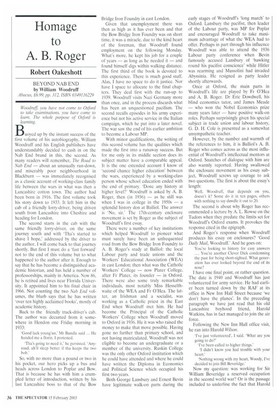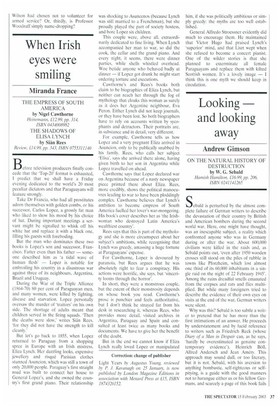Homage to A. B. Roger
Robert Oakeshott
BEYOND NAB END by William Woodruff
Abacus, £6.99. pp. 312, ISBN 0349116229 Woodruff you have not come to Oxford to take examinations, you have come to learn. The whole purpose of Oxford is learning.
Buoyed up by the instant success of the first volume of his autobiography. William Woodruff and his English publishers have understandably decided to cash in on the Nab End brand in this, the second. As many readers will remember, The Road to Nab End — about an unusually run-down, and miserably poor neighbourhood in
Blackburn was immediately recognised as a classic account of working-class family life between the wars in what was then a Lancashire cotton town. The author had been born in 1916. The first volume took his story down to 1933. It left him in the cab of a friendly lorry-driver, being driven south from Lancashire into Cheshire and heading for London.
The second starts in the cab with the same friendly lorry-driver, on the same journey south and with 'Ma's started to shave I hope,' addressed by the driver to the author. I will come back to that journey shortly. But first I must do a 'fast forward' not to the end of this volume but to what happened to the author after it. Enough to say that he has become a distinguished academic historian, and has held a number of professorships, mainly in America. Now 86, he is retired and lives near Florida University. It appointed him to his final chair in 1966. Not counting the two Nab End volumes, the blurb says that he has written 'over ten highly acclaimed books', mostly of academic history.
Back to the friendly truck-driver's cab. The author was decanted from it somewhere in Hendon one Friday morning in 1933:
'Good luck young'un.' Mr Bundle said ... He handed me a florin. I protested.
'Tha's going to need it,' he persisted. 'Anyroad, ah'll sleep better if tha keeps the two bob.'
So, with no more than a pound or two in his pocket, our hero picks up a bus and heads across London to Poplar and Bow. That is because he has with him a crumpled letter of introduction, written by his last Lancashire boss to that of the Bow
Bridge Iron Foundry in east London.
Given that unemployment there was then as high as it has ever been and that the Bow Bridge Iron Foundry was on short time, it was a miracle, due to the kind heart of the foreman, that Woodruff found employment on the following Monday. What's more, he kept his job for a couple of years — as long as he needed it — and found himself digs within walking distance. The first third of the book is devoted to this experience. There is much good stuff. Alas, I have no space to do it justice. Nor have I space to allocate to the final chapters. They deal first with the run-up to 1939. Woodruff visits Nazi Germany more than once, and in the process discards what has been an unquestioned pacifism. The second recalls episodes in his army experience but not his active service in the Italian campaign, which he put into a later novel. The war saw the end of his earlier ambition to become a Labour MP.
With minor qualifications, the writing of this second volume has the qualities which made the first into a runaway success. But for me only in its middle section does its subject matter have a comparable appeal. It is the one extended account I know of 'second chance higher education' between the wars, experienced by a working-class person whose school education ended with the end of primary. 'Done any history at higher level?' Woodruff is asked by A. B. Roger, then (in 1936) — as he still was when I was in college in the 1950s — a splendid history don at Balliol. The answer is 'No, sir.' The 17th-century enclosure movement is set by Roger as the subject of Woodruff s first essay.
There were a number of key institutions which helped Woodruff to pioneer what must surely have been an unfrequented road from the Bow Bridge Iron Foundry to A. B. Roger's study at Balliol: the local Labour party and trade unions and the Workers' Educational Association (WEA) in east London; then what was the Catholic Workers' College — now Plater College, after Fr Plater, its founder — in Oxford. There were also some truly remarkable individuals, most notably Miss Hesselthwaite of the WEA and Fr O'Hea. The latter, an Irishman and a socialist, was working as a Catholic priest in the East End when Woodruff met him. He had become the Principal of the Catholic Workers' College when Woodruff moved to Oxford in 1936. He it was who raised the money to make that move possible. Having gone no further than primary school, and not having matriculated, Woodruff was not eligible to become an undergraduate or a member of the university. Ruskin College was the only other Oxford institution which he could have attended and where he could have written the Diploma in Economics and Political Science which occupied his first two years.
Both George Lansbury and Ernest Bevin have legitimate walk-on parts during the
early stages of Woodruffs 'long march' to Oxford. Lansbury the pacifist, then leader of the Labour party, was MP for Poplar and encouraged Woodruff to take maximum advantage of what the WEA had to offer. Perhaps in part through his influence Woodruff was able to attend the 1936 Labour party conference when Bevin famously accused Lansbury of 'hawking round his pacifist conscience' while Hitler was rearming and Mussolini had invaded Abyssinia. He resigned as party leader shortly afterwards.
Once at Oxford, the main parts in Woodruffs life are played by Fr O'Hea and A. a Roger. Dr Eric Dowdwell, his blind economics tutor, and James Meade — who won the Nobel Economics prize many years later — have positive walk-on roles. Perhaps surprisingly given his special subject in trade union and labour history, G. D. H. Cole is presented as a somewhat unsympathetic teacher.
However, by the number and warmth of the references to him, it is Balliol's A. B. Roger who comes across as the most influential of Woodruffs intellectual mentors at Oxford. Snatches of dialogue with him are also warmly reported. Having swallowed the enclosure movement as his essay subject, Woodruff screws up courage to ask two questions. The first is about the essay's length:
Well, Woodruff, that depends on you, doesn't it? Some do it in ten pages, others with nothing to say dawdle it out to 20.
The second is about why Roger has recommended a lecture by A. L. Rowse on the Tudors when they predate the limits set for Woodruffs Oxford exams. It provokes the response cited in the epigraph.
And Roger's response when Woodruff produces his essay on enclosures? 'Good Daily Mail, Woodruff.' And he goes on:
You're looking to history for easy answers You're another Clever Dick condemning the past for being short-sighted. What generation has ever looked beyond the end of its nose?
I have one final point, or rather question. The date is 1940 and Woodruff has just volunteered for army service. He had earlier been turned down by the RAF at its office in New Inn Hall Street because 'we don't have the planes'. In the preceding paragraph we have just read that his old Lancashire boyhood friend, Harold Watkins, has in fact managed to join the air force.
Following the New Inn Hall office visit, he ran into Harold Wilson.
'I've just volunteered', I said. 'What are you going to do?'
I've been called to higher things.'
'I didn't know you had trouble with your heart.'
'Nothing wrong with my heart, Woody, I've decided to join Bill Beveridge.'
Now my question: was working for Sir William Beveridge a reserved occupation in the second world war? Or is the passage included to underline the fact that Harold Wilson had chosen not to volunteer for armed service? Or, thirdly, is Professor Woodruff simply name-dropping?



































































 Previous page
Previous page